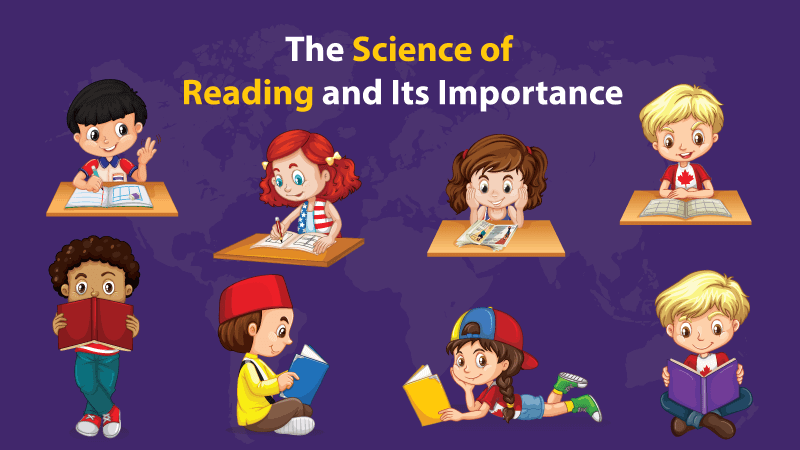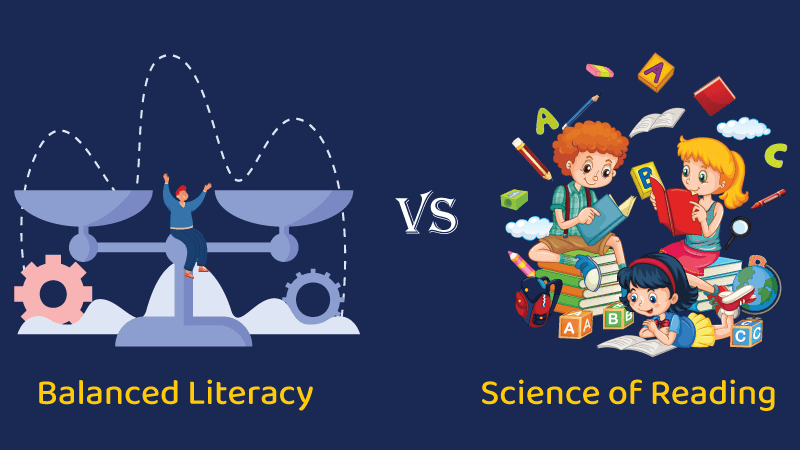
The science of reading holds a crucial role in shaping our cognitive abilities, expanding our knowledge horizons, and fostering intellectual growth. From the earliest stages of human development, the act of reading has been instrumental in the transmission of ideas, culture, and innovation.
In this article, we dive deep into the intricacies of the science of reading and emphasize its profound importance in our lives, the significance of the science of reading, and its multifaceted importance in personal and academic growth.
What Is the Science of Reading?
The science of reading is a thorough and evidenced-based approach to comprehending how individuals learn to read and how reading challenges can be successfully handled.
This method acknowledges that reading is a difficult ability that requires word decoding, understanding word meanings, and contextualizing material. The Science of Reading also recognizes the crucial part that brain development plays in learning to read.
It places emphasis on the value of developing vocabulary, using comprehension techniques, fluency, and developing phonological awareness (the capacity to identify and manipulate specific sounds in words), as well as phonics (the relationship between sounds and written symbols).
Understanding the Science of Reading
Reading is not just a simple act of decoding letters and words on a page; it is a complex cognitive process that engages various regions of the brain. When we read, our brains are not merely recognizing symbols but also constructing meaning from the text.
This intricate process seamlessly integrates visual, linguistic, and cognitive skills. When we lay our eyes on a text, our brain engages in a dance of decoding letters, recognizing words, and comprehending sentences.
The visual cortex processes the shapes of letters, while the language centers interpret their meanings. This amalgamation of visual and linguistic processing culminates in the creation of mental images and concepts, forming the building blocks of understanding.
Read More: What is Balanced Literacy? Balanced Literacy vs Science of Reading
Process of Science of Reading
Our brains generate meaning from the text as we read rather than just identifying the symbols. A seamless integration of visual, verbal, and cognitive abilities is required for this complex process.
- Visual Processing
- Phonological Awareness
- Vocabulary and Semantics
- Syntax and Grammar
- Cognitive Processing
Visual Processing
Visual processing is the initial step in the science of reading. Our eyes scan the text, and the brain quickly identifies letters and words. This initial stage is vital because it lays the groundwork for future comprehension. Efficient visual processing is essential for fluent reading and prevents cognitive strain.
Phonological Awareness
The ability to recognize and manipulate sounds in spoken language is referred to as phonological awareness. This skill is closely linked to reading as it helps individuals understand the relationship between letters and their corresponding sounds. Phonological awareness lays the groundwork for accurate word recognition and decoding.
Vocabulary and Semantics
Building a solid vocabulary is paramount for adequate reading comprehension. The more words a reader knows, the more they will understand the text's details.
Additionally, understanding the semantics of words and how they interact within sentences enhances comprehension.
Syntax and Grammar
Syntax and grammar provide the structural framework for written language. A solid grasp of sentence structure and grammar rules enables readers to extract meaning accurately. Sentences with proper syntax flow smoothly and convey ideas coherently.
Cognitive Processing
The culmination of visual, linguistic, and cognitive processes leads to cognitive processing, where the brain synthesizes all the gathered information to create a coherent mental representation of the text. This mental model allows readers to understand context, make predictions, and draw conclusions.
How Reading Shapes the Brain
Scientific studies have unveiled the remarkable impact of reading on brain structure. Neuroplasticity, the brain's ability to reorganize itself, is significantly influenced by reading.
Areas associated with language processing, such as Broca's and Wernicke's areas, exhibit enhanced connectivity and activity in proficient readers. Moreover, reading fosters the development of white matter tracts that facilitate efficient communication between different brain regions.
This neurological remodeling not only refines language skills but also strengthens cognitive functions like analytical thinking and problem-solving.
The Five Key Components of Reading
The education landscape is constantly evolving, and when it comes to reading instruction, understanding the key elements that contribute to reading success is essential.
1. Phonemic awareness
Phonemic awareness is a fundamental ability that comes before phonics. It entails identifying and manipulating individual phonemes, which are the smallest sound elements in the language.
Developing phonemic awareness hones students' ability to distinguish between sounds, blend them to form words, and segment words into phonemes. Engaging activities like rhyming, blending, segmenting, and manipulating sounds equip learners with the auditory skills necessary for reading and spelling success.
2. Phonics
The relationship between letters and their matching sounds is the core of phonics instruction. It empowers readers to decode words accurately by understanding the phonetic patterns and rules of the English language.
Phonics instruction begins with letter-sound associations and progresses to more complex phonetic patterns. By mastering phonics, students gain the tools to independently decode unfamiliar words and improve their overall reading fluency.
3. Fluency
Fluency is the link between word recognition and comprehension. It refers to the capacity to read accurately, quickly, and expressively. Fluent readers can decipher words and phrases with ease, allowing them to concentrate on grasping the meaning of the text.
Reading fluency is nurtured through repeated practice and exposure to a wide range of texts. Strategies like timed readings, partner reading, and modeling fluent reading help students develop this essential skill.
4. Vocabulary
A wide range of words is essential for good communication and reading comprehension. While reading, readers come across many words, and a strong vocabulary allows them to absorb complex meanings and connotations.
Explicit vocabulary instruction, contextual word learning, and exposure to diverse genres contribute to vocabulary growth. Moreover, educators can guide students to use context clues, prefixes, suffixes, and word roots to decipher unfamiliar words.
5. Comprehension
It is the ability to understand, analyze, and interpret written text. Comprehension is not passive; it involves actively engaging with the material, making connections, and drawing conclusions.
Readers with strong comprehension skills can grasp the main ideas, identify supporting details, infer meanings, and critically evaluate the content. Effective reading instruction focuses on strategies that enhance comprehension, such as asking questions, making predictions, and summarizing.
The Importance of Reading
Understanding the science of reading is an academic pursuit and a gateway to personal and intellectual enrichment. The benefits of reading are multifaceted and extend across various domains.
Knowledge Acquisition
Reading is the primary means through which we acquire new information. Whether exploring the pages of a history book, diving into science fiction, or staying updated with the latest news, reading broadens our horizons and keeps us informed.
Cognitive Stimulation
Engaging with written content stimulates the brain's neural pathways, promoting cognitive growth and mental agility. Regular reading has been shown to reduce the risk of cognitive decline, enhancing critical thinking and problem-solving skills.
Language Development
Reading is essential for children's language development. Exposure to various words and sentence structures enhances vocabulary, language comprehension, and communication skills.
Empathy and Perspective-Taking
Fictional literature, in particular, allows readers to immerse themselves in different characters' lives and experiences. This fosters empathy and the ability to see the world from diverse perspectives, nurturing emotional intelligence.
Stress Reduction
Escaping into a well-written book provides an effective way to unwind and alleviate stress. Reading allows individuals to momentarily detach from their daily worries and immerse themselves in captivating narratives.
Lifelong Learning
The pursuit of knowledge doesn't have an expiration date. Reading enables lifelong learning by offering a continuous stream of information and ideas. Reading keeps the mind active and curious, whether you are young or elderly.

